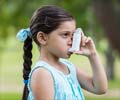- A new guideline for healthcare professionals who treat children with asthma has been released.
- It is called “The Pediatric Asthma Yardstick.”
- It provides relevant recommendations for each step-up and each intervention to doctors and improves treatment.
"Differences in diagnosis and management of asthma in children reflect differences in development of their respiratory systems, particularly for younger children," says Leonard Bacharier, MD, co-author of the yardstick. "Other factors include challenges related to daily activities and emotional and social concerns, particularly for adolescents. Comorbid conditions and non-adherence with treatment (eg; due to the stigma of having a chronic condition and taking medicine) can affect outcomes for older children."
Although asthma often begins in early childhood, diagnosing asthma in the very young child is challenging because it is based largely on symptoms and is not easily confirmed by objective testing, such as lung function. Additionally, symptoms, notably wheezing and coughing, often are related to, or occur with, common viral infections. Pediatric data for medicines are limited and robust clinical studies attesting to efficacy and safety of asthma medications are few.
"The Pediatric Asthma Yardstick is a practical resource for identifying children with uncontrolled asthma who need a step-up in controller medicine," says Dr Chipps. "It describes how to start and/or adjust controller therapy based on the options that are currently available for children, from infants to 18 years of age. The recommendations are presented around patient profiles, by severity and age, and are based on current best practice strategies according to the most recent data and the authors’ clinical experience."
References:
- The Pediatric Asthma Yardstick - (https://www.annallergy.org/article/S1081-1206(18)30253-9/fulltext)















